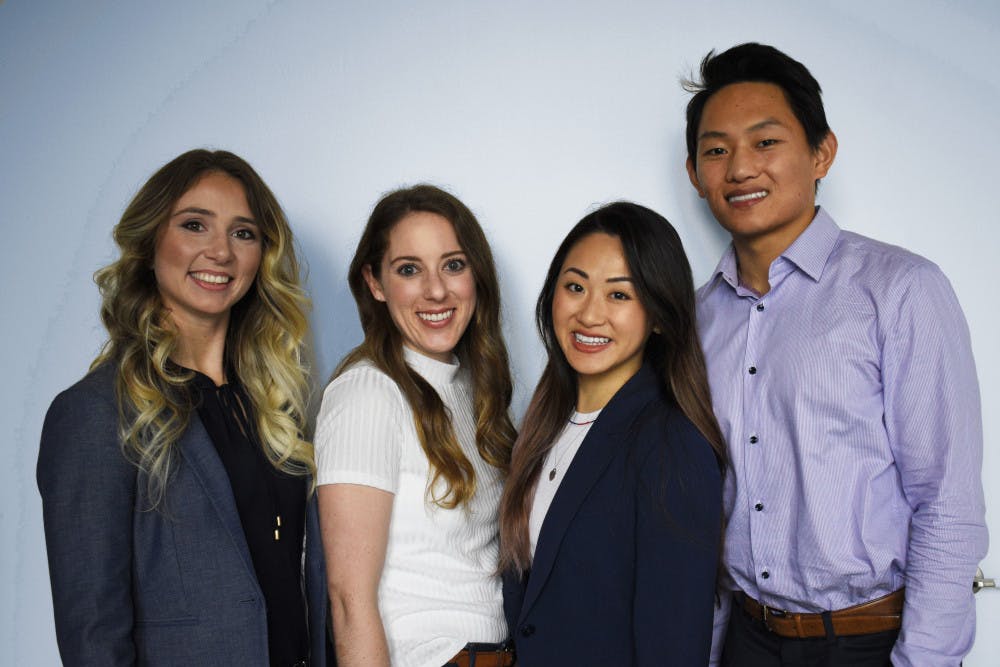Jennifer Steger ’13, co-founder of medical device startup company Nanodropper, was named alongside her cofounders to the Forbes 30 Under 30 Healthcare list of honorees this year.
Nanodropper has designed a more cost-effective eye-drop bottle adapter of the same name, which reduces the size of eyedrops up to 60 percent, according to their company’s website. The Nanodropper has the potential to save patients affected with glaucoma, an eye condition that causes nerve damage and potential blindness, hundreds of dollars on medicinal eyecare.
Steger, who currently serves as the company’s chief scientific officer, co-founded Nanodropper in July 2018 with Chief Executive Officer Allisa Song, Chief Operations Officer Elias Baker and Chief Commercialization Officer Mackenzie Andrews. They founded Nanodropper to offer a solution to a 2017 ProPublica article that reported on the costly waste of eye drop bottles intentionally designed to release large drops that spillover.
The article “really resonated with us — the inequity that people were experiencing, based on this medication that they needed (to) maintain their eyesight,” Steger said.
While Steger was an undergraduate, she researched in a lab under the mentorship of Nicole Cyr, an associate biology professor at Stonehill College who was a postdoctoral research fellow at the time. According to Cyr, Steger was “an outstanding student.”
“She’s not just bright, but she’s curious, and she is very, very persistent,” Cyr said. “I’m not surprised that she’s been successful in this endeavor as well.”
Following graduation, Steger joined a lab at the University of Washington, where she met cofounders Song and Andrews. She joined them in pursuing the idea for the Nanodropper to make a “direct and immediate contribution to addressing inequities in healthcare,” Steger said.
As the principal scientist on the team, Steger “really holds the backbone of our company when it comes to scientific rigor and making sure that we aren't making decisions without data,” Song told The Herald.
Research has shown that African Americans and people of Latinx descent are predisposed to glaucoma, and women are more likely to be diagnosed than men, Steger said. Uninsured or underinsured patients with glaucoma are also affected by the cost of losing eye drops due to spillover.
To mitigate this problem, Steger found that eyedrop size could be reduced to a range of seven to 10 microliters. Having gained prototype funding and equipment from the University of Washington, the Nanodropper team went through several iterations before achieving the desired drop size and beginning the manufacturing process in the fall of 2019, she said.
The product was designed to not only be functional, but also easy to use for elderly patients and patients with low vision, Andrews said. The team considered the feel of the product for customers who have less dexterity in their hands and chose a bright blue color for the top end of the adapter to more easily align the drop to the eye, Baker added.
The team also used customer interviews with eyecare professionals and patients to inform the design process. “We really tried to go one step beyond just solving this problem of oversized eyedrops, and tried to improve every aspect of the eyedrop experience that we could with a simple medical device,” Andrews said.
The Nanodropper was a brand new device in the medical industry at the time of its release, uncommon in that it did not build on or compete with a prior product, Andrews said. Though there were challenges in creating new marketing approaches and distribution pathways, it was a “huge benefit” to not have to compete directly with large healthcare companies.
After a delay caused by their U.S. manufacturers having to produce COVID-19 equipment instead, Nanodropper’s product was launched in June 2020 and is now recognized on a national level.
The group attributes the success of the startup to the team dynamic and the different skills that each member has contributed — “a dream team,” Andrews said.
The startup has recently launched a “Give the Gift of Vision” program, where customers can purchase a “Pay-It-Forward” Nanodropper on behalf of those who cannot afford it.
Nanodropper plans to expand their reach with global partners, such as the Aravind Eye Care System that has hospitals in India and Africa, Andrews said.
For Baker, joining the list of Forbes 30 Under 30 honorees was an unimaginable achievement, who read Forbes’ articles during high school.
“It was like a confirmation that we’re not just a student team anymore,” Andrews said. “We’re really doing something that means a lot to the future of healthcare.”
Correction: A previous version of this article incorrectly identified June 2020 as the year Nanodropper was co-founded; the company was founded in July 2018. The article also stated that the team went through hundreds of iterations, when in fact they only went through several. The article misidentified Nicole Cyr as a former postdoctoral research student, but she was actually a former postdoctoral research fellow. The Herald regrets the errors.





